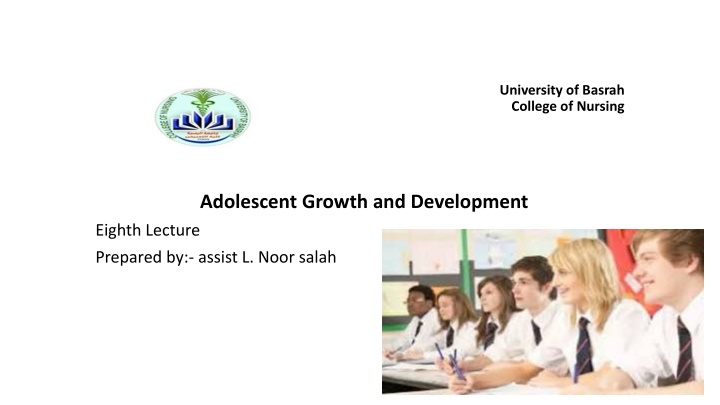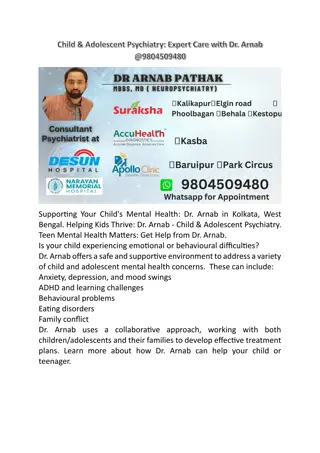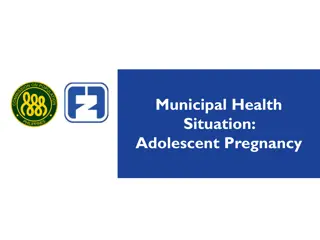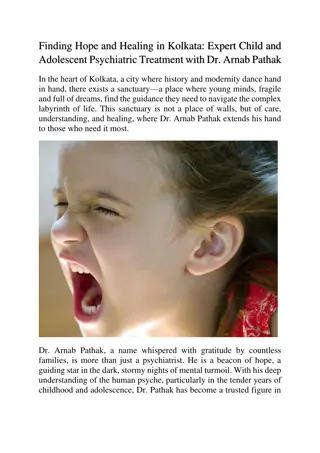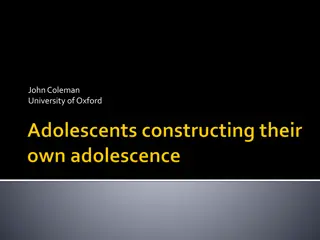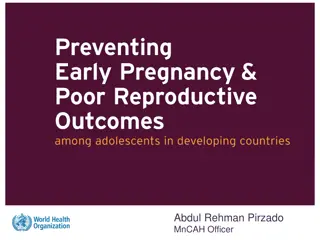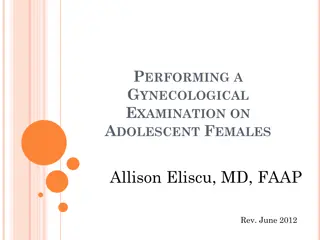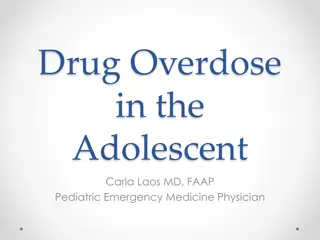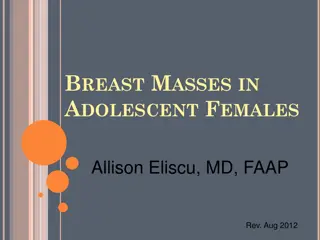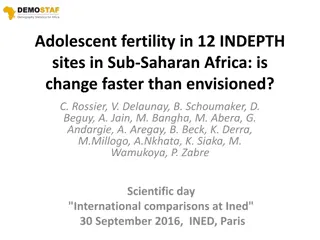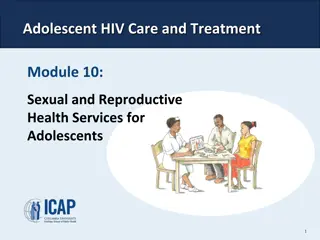Adolescent Growth and Development: A Comprehensive Overview
Adolescence is a crucial transition period from childhood to adulthood marked by rapid physical, emotional, and social changes. This stage involves significant growth spurts, such as in height and weight, as well as physiological developments like changes in pulse rate and skin activity. Cognitive development also plays a key role during this period as adolescents work towards mastering developmental tasks essential for successful progression. Understanding the complexities of adolescent growth and development is vital for healthcare professionals, educators, and parents to support teenagers effectively.
Download Presentation

Please find below an Image/Link to download the presentation.
The content on the website is provided AS IS for your information and personal use only. It may not be sold, licensed, or shared on other websites without obtaining consent from the author.If you encounter any issues during the download, it is possible that the publisher has removed the file from their server.
You are allowed to download the files provided on this website for personal or commercial use, subject to the condition that they are used lawfully. All files are the property of their respective owners.
The content on the website is provided AS IS for your information and personal use only. It may not be sold, licensed, or shared on other websites without obtaining consent from the author.
E N D
Presentation Transcript
University of Basrah College of Nursing Adolescent Growth and Development Eighth Lecture Prepared by:- assist L. Noor salah
Adolescent Growth and Development Adolescence is a transition period from childhood to adulthood. It is based on childhood experiences and accomplishments. Adolescence spans the ages of about 13 to 18 years. Some males do not complete adolescence until they are 20 years old. The rate of development during adolescence varies greatly from one teen to another. It is a time of many physical, emotional, and social changes. During this period, the adolescent is engaged in a struggle to master the developmental tasks that lead to successful completion of this stage of development. Adolescence" comes from the Latin word meaning "to come to maturity."
Physical growth Rapid growth occurs during adolescence. Girls begin growing more rapidly during the preadolescent period and achieve 98% of their adult height by the age of 16. Boys start their growth spurt, a period of rapid growth, around 13 years of age and may continue to grow until 20 years of age Early adolescence (preadolescence) begins at about age 10 in girls and about age 12 in boys with a dramatic growth spurt that signals the advent of puberty (reproductive maturity).
Preadolescence begins in the female between the ages of 9 and 11 years and is marked by a growth spurt that lasts for about 18 months. Menarche (the beginning of menstruation), after which growth slows considerably. Boys enter preadolescence a little later, usually between 11 and 13 years of age, 6nd grow generally at a slower, steadier rate than do girls. In boys, the appearance of nocturnal emissions (wet dreams) is often used as the indication that the preadolescent period has ended.
Physical development includes rapid gains in height and weight: Weight Males: Highly variable, gain 7 to 30 kg. Females: Highly variable, gain 7 to 25 kg Height By the age of 13, the adolescent triples his birth length. Males: Highly variable, gain 10 to 30 cm Females: Highly variable, gain 5 to 20 cm. Growth in height ceases at 16 or 17 years in females and 18 to 20 in males
Physiological growth Pulse: Reaches adult value 60 80 beats/min. Respiration: 16 20C/minute. Note :The sebaceous glands of face, neck and chest become more active. When their secretion accumulates under the skin in face, acne will appear.
Cognitive Development Through formal operational thinking, adolescent can deal with a problem. Thought became more abstract more idealistic, and more logical. Teenagers accumulate general knowledge and start applying the learned concepts to new tasks. Interest in learning life skills, such as cooking, fixing things, and driving Concept such as justice, truth, beauty, and power can be understood.
Emotional development: This period is accompanied usually by changes in emotional control. Adolescent exhibits alternating and recurrent episodes of disturbed behavior with periods of quite one. He may become hostile or ready to fight, complain or resist everything. Social development: He needs to know "who he is" in relation to family and society, i.e., he develops a sense of identity. If the adolescent is unable to formulate a satisfactory identity from the multi-identifications, sense of self-confusion will be developed according to Erikson develop sense of (identity vs role confusion )
Social development:- Adolescent shows interest in other sex. He looks for close friendships As teenagers gain independence they begin to challenge Values Critical of adult authority Relies on peer relationship
Psychosexual development Freud: Genital stage - Hypothalamus stimulates secretion of pituitary gonadotropins, leading to reproductive maturity. - Development of both primary and secondary sex characteristics.
Appearance of secondary sex characteristics 1- Secondary sex characteristics in girls: Increase in transverse diameter of the pelvis. Development of the breasts Change in the vaginal secretions. Growth of pubic and axillary hair. Menstruation (first menstruation is called menarche, which occurs between 12 to 13 years).
2- Secondary sex characteristics in boys: Increase in size of genitalia. Swelling of the breast. Growth of pubic, axillary, facial and chest hair. Change in voice. Rapid growth of shoulder breadth. Production of spermatozoa (which is sign of puberty).
Psycho-Social Development Erikson: Identity vs. role confusion There are five recognized psychosocial issues that teens deal with during their adolescent years. These include: 1. Establishing an identity The question of "who am I?" The eventual outcome is people who have a clear sense of their values and beliefs, occupational goals, and relationships expectations. 2. Establishing autonomy: Establishing autonomy means becoming an independent and self-governing person within relationships.
3. Establishing intimacy Many people, including teens, equate intimacy with sex. Intimacy people are open, honest, caring and trusting Most intimate relationships during adolescence are heterosexual, or between members of the opposite sex. Sometimes, however, young people form intimate attachments with members of the Same Sex, homosexual relationships. 4. Becoming comfortable with one's sexuality: The teen years are the prime time for the development of sexuality 5. Achievement. The teen years are a time when young people can begin to see the relationship between their current abilities and plans and their future vocational aspirations.
Common needs during adolescence period 1. Increased Nutritional Needs A. Calories Adolescent Boys ages 11 to 18 needs between 2,500 and 2, 800 calories each day. Adolescent girls need approximately 2.200 calories each day. B. Protein Protein is important for growth and maintenance of muscle Adolescents need between 45 and 60 grams of protein each day.
C. Calcium Daily requirement I .20 0 milligrams of calcium. D. Iron Adolescent boys need 12 milligrams of iron each day, while girls need15 milligrams.
Adolescent Needs 1. Adolescent Sleep Needs 2. Relationships 3. Love and respect from other 4. Privacy 5. Playing and exercise 6. Nutrition
Adolescent developmental problems 1. Nutrition problems (Anorexia nervosa ,Bulimia and Pica ) 2. Attention deficit 3. Anger issues 4. Acne 5. Drug and alcohol abuse. 6. Psychological problems( Depression and Suicide). 7. Postural disorder 8. Nocturnal emission 9. Masturbation 10. Menstrual problems (amenorrhea, dysmenorrheal ) 11. Sleep problems (nightmares ,insomnia) 12. Obesity 13. Bad school performance
Summary of Milestones for adolescent Fine motor skills well-developed. Gross motor skills improve due to growth spurts. Able to apply abstract thought and analysis.
